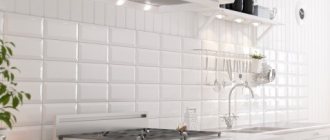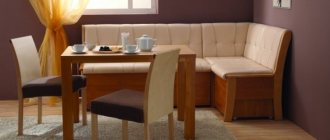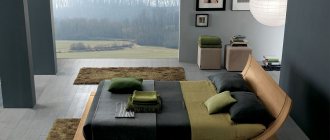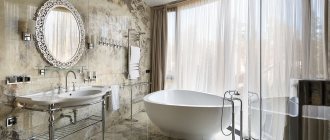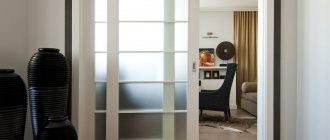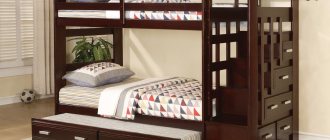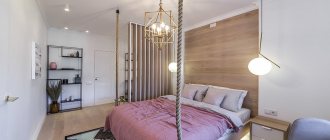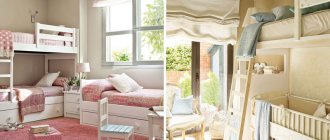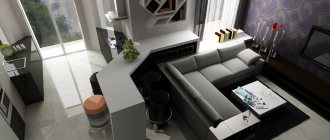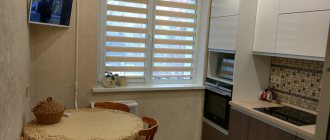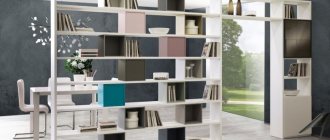The design of the floor in the kitchen can be very different. First of all, the design depends on the type of material chosen. For example, porcelain tiles are larger in format than tiles, and there are also ceramic parquet, engineered boards, and self-leveling floors. Kitchen floor tiles with a design in a specific style are usually the most practical yet economical solution. We recommend marble-effect porcelain tiles for the highest quality and professional repairs.
In this article we will show you photos of kitchen floor designs that will be the most interesting and original. We will also look at various styles in interior design, fashion trends and design solutions that look great in a particular area.
We will also show successful options for zoning and floor design in the living room kitchen and floor design in the hallway and kitchen, when these two rooms are connected to each other by an open plan. You will see that floor finishing is very important in visual zoning.
The design of a kitchen floor in porcelain stoneware will be the most appropriate solution for business class and luxury renovation. We also recommend natural marble for luxury design. Now in interior design, the most popular kitchen renovations are those with beautiful marbled porcelain stoneware floors. Finishing the kitchen floor with porcelain tiles to look like concrete, stone or wood (in the form of complex parquet or simple floorboards) is also in fashion.
The design of walls and floors in the kitchen are also very connected. Sometimes we even see the same material being used for interior decoration. In this article, we will separately look at colors for kitchen flooring and different styles of kitchen flooring.
Pros and cons of tiling floors
There are several positive and negative qualities of this cladding.
| pros | Minuses |
| It is characterized by durability, practicality, strength and wear resistance. | It is quite cold and has poor thermal conductivity. |
| Easy to clean using any chemicals. | This finish is very hard, making it more traumatic. |
| It can have a huge variety of color shades, textures and types of surfaces, which allows you to choose a design to suit any design. | Requires additional sound insulation. |
| Ceramics with a shiny surface quickly develop scuffs and scratches. | |
| It has a fairly simple installation that you can do yourself. | Laying tiles requires a lot of time and financial costs. |
The positive aspects of a seamless floor
An interesting aspect of modern seamless flooring is the continuity effect, which gives a very pleasing look, especially in open space settings.
Open space is the optimal solution for making small rooms more spacious, for example, a house with a small kitchen or a combined living room without the use of intermediate walls, the space will be larger, more spacious and brighter.
The continuity that a solid floor gives us certainly creates a harmonious effect with the furniture, making the environment more comfortable and relaxing.
If we want to create a solid floor, we need to pay even more attention to two aspects:
- Tiling - Given that you always need to rely on qualified installers, in this case the choice is even more important. To the layman, installing a floor without joints may seem easier than a floor with joints, but in fact it is the exact opposite. In fact, joints sometimes serve to hide small defects; Since there are no seams, any small mistake can be critical to the success of the installation;
- Quality of the tiles - If we decide to create a floor without joints, we must also pay special attention to the quality of the tiles. The choice to use rectified tiles in this case is mandatory, since it is necessary to inform the seller that we want to lay the floor using this technique.
Which tile to choose for the kitchen floor?
Depending on the composition, tile products are divided into the following types:
- Ceramic. It is a classic version on a clay basis, made by firing. Ceramics retains its presentable appearance for a long time, does not electrify, does not accumulate dust and is not afraid of temperature changes. It can have several varieties, for example, glazed, unglazed or small-format metlakh.
- Porcelain tiles. It is very durable, wear-resistant, easy to clean and resistant to various types of stains. Porcelain tiles fit perfectly into any style and have an elegant, luxurious appearance; they can imitate stone patterns and have a matte, polished or rough surface.
- Quartz vinyl. A modern type of tile consisting of several layers with the addition of quartz sand and fiberglass. Quartz vinyl products are non-slippery, perfectly protect against moisture, and are characterized by high-quality noise insulation and fire resistance.
Aesthetically attractive and functional tile cladding, thanks to the huge range, colors and variety of shapes, can satisfy any financial capabilities and stylistic preferences.
The photo shows a kitchen interior with multi-colored hexagon-shaped ceramic tiles on the floor.
How to choose?
In order for you to come to the store to buy tiles with knowledge of the matter, we will arm you with useful information that will definitely help you navigate and make the best choice.
Types of tiles
Floor tiles most often come in 3 types:
- ordinary ceramic - the most common type, which has the necessary set of performance characteristics and ensures stable service for 10-20 years;
- porcelain stoneware (gres) - hardened at a higher temperature and acquires a monolithic structure, the characteristics most similar to stone;
- clinker is a façade ceramic made using extrusion technology and is used primarily outdoors.
There are also so-called quartz-vinyl tiles, but they have nothing to do with ceramics, so we’ll take them outside the scope of our material.
Despite the fact that you can use both regular ceramic tiles and porcelain tiles for the kitchen floor, we still recommend choosing the second option. It may be more expensive, but it outright outperforms classic ceramics in terms of characteristics: it is more durable and wear-resistant, it has a much greater chance of surviving a confrontation with a dropped pan or plate.
Attention: very often sellers in tile stores, either intentionally or out of ignorance, confuse ordinary tiles with porcelain stoneware, without attaching much importance to the difference between them. But you can tell one from the other yourself if you pick up a fragment: porcelain stoneware is most often uniform throughout the entire thickness of the tile - unlike classic floor ceramics, in which the top layer with the enamel applied to it is clearly visible.
Specification
Here we need to clarify some points. Typically, tile stands have stickers indicating one specification or another. If this is not the case, then you can get information from the catalog or simply by looking at the box with tiles:
- anti-slip coefficient - must be at least 0.75, designated as R10;
- wear resistance - at least hardness class III according to PEI or class V according to GOST;
- resistance to chemically active substances - AA marking;
- resistance to stains - according to the ISO 10545-14 standard, level 3 is optimal.
Sizes and formats
Installing tiles is not the most fun task, so it makes sense to simplify it by minimizing the cutting of material. In addition, this will allow you to minimize your costs. Therefore, before you go to the store, think about what size tiles will look best in the format of your kitchen. The most common options are:
- square (in cm: 30x30, 40x40, 50x50, 60x60);
- rectangular (in cm: 15x30, 20x40, 30x60);
- modular (diamond, small squares 10x10 or 15x15).
Everything is simple here: the larger your kitchen is, the larger the tiles you can put on the floor. For example, for modest Khrushchev buildings, where there is no room to turn around, the classic size 30x30 would be optimal. And in rooms with a good supply of usable space, 50x50 tiles will look quite organic.
Advice: even if you have a solid square footage, but the floor suffers from unevenness, it is still better to look towards compact formats. Smaller tiles can hide them all perfectly.
Floor tile colors
The tint solution is very important in interior design. Floor finishing can be equally well done in both bright and more muted colors.
Black
It perfectly combines practical and artistic components, allows you to show limitless imagination and gives inexhaustible inspiration in interior decoration.
The photo shows square black tiles on the floor in a loft-style kitchen interior.
White
It has a strong reflective effect, due to which sunlight and artificial light multiply in the room, giving the space lightness, radiance, airiness and freshness. This light cladding will be especially relevant for a small kitchen in a Khrushchev-era building.
Beige
Warm beige tones, due to their versatility, are ideal for almost any interior design and add the necessary coziness to the environment.
Gray
It is a strict, but at the same time very chic design, allowing you to create an interesting and balanced design.
The photo shows a kitchen with a floor decorated with gray tiles with a glossy surface.
Brown
It is very relevant, evokes associations with a noble, monumental and calm interior and adds coziness to any kitchen space.
Red
Such a rich, bright cladding radically changes the external appearance of the interior, allows you to go beyond the usual and makes the environment truly unique. The terracotta shade deserves special attention, it combines red, brown and orange shades and gives the atmosphere nobility and naturalness.
Combination of several colors
A combination of multi-colored products, traditional black and white contrast, spectacular purple and yellow, pink and black or blue and white will create an original design and simulate the geometry of the kitchen space.
The photo shows a classic combination of black and white tiles in the interior of a small kitchen.
Advantages of decorating kitchens in blue
Blue color is ideal for people watching their weight and wanting to lose weight. It is believed that under its influence the appetite becomes worse and we eat less. But even those who do not adhere to diets often choose it to decorate their kitchen, which is due to a number of reasons:
- A kitchen decorated in blue shades visually looks taller and wider. If you combine it with white, you can make it lighter. In combination, these colors make the room spacious, add lightness and air. While blue can weigh down objects and add bulk, its lighter counterpart has the opposite effect. Therefore, he is able to make even the smallest kitchen larger and more comfortable.
- Blue color has a beneficial effect on the human psyche. It promotes relaxation, gives a feeling of peace and tranquility. It is enough to remember the emotions that the blue sky or the surface of the sea evokes in us. A kitchen decorated in this color can evoke approximately the same sensations.
- Azure tones go well with other shades from neutral and light to bright and rich.
As for the disadvantages of this color scheme, you need to take into account that an excess of blue can provoke a feeling of fatigue and even depression. Therefore, it is recommended to dilute it with others.
IMPORTANT! This color scheme should not be used for a kitchen that is not located on the sunny side - it may turn out to be too cold. On the contrary, blue color is ideal if the windows face south or southeast - it will add pleasant coolness.
Tile layout options
The most common installation option is to arrange square or rectangular tile products in even rows. A spaced layout on the floor, reminiscent of brickwork or diagonal placement, which also looks very unusual and also allows you to visually expand the space, looks much more interesting on the floor.
The layout of rectangular tiles in a herringbone pattern is considered to be quite complex, but at the same time very effective. Also, the modules can be arranged in a checkerboard pattern, combining different color combinations.
The photo shows the design of a modern kitchen and black floor tiles laid out diagonally.
Impact on humans
Many people associate blue tiles with stereotyped bathrooms from the times of the Soviet Union. Few people will like gloomy, gloomy and deliberately cold rooms. Modern interiors, where blue tiles of various shades are used, are far from primitive “scoop” finishes.
Ceramic manufacturers offer textured, elegant-looking products in a variety of shades. Sapphire, ultramarine, cornflower blue, sky and azure ceramic tiles look elegant and stylish. Those who are afraid to decorate walls or floors with such finishing use mosaic decor with an abundance of secondary shades as an alternative.
Turquoise tiles in the bathroom
Bathroom decor with blue tiles
From a physiological standpoint, blue color has a strong effect on humans. In a room where the indigo shade dominates, a person’s blood pressure decreases, the pain threshold decreases, and cephalgia is more easily tolerated. The blue palette can calm emotional tension and reduce the level of pathological activity.
Decorative insert of blue tiles in the bathroom
Curly blue tiles in the kitchen
Shapes and sizes of floor tiles
There are several main varieties of sizes and shapes.
Square or rectangular
Tiled rectangular or square modules, despite their simplicity, give the floor a very expressive look and model the space, for example, making a long and narrow kitchen much more proportional.
The photo shows square patterned tiles on the floor in the interior of a classic kitchen.
Diamond
This geometric coating always looks advantageous and quite unusual and has a truly elegant appearance.
Honeycomb
This hexagonal shape resembles a honeycomb and looks very natural. This figured floor finish is an original, unusual, but not too pretentious design.
Big
Large-format modules add a certain zest to the decor, and due to the minimal number of seams and joints with high-quality epoxy grout, they give the floor a solid look.
The photo shows the kitchen interior and the floor, lined with large square tiles with an aged effect.
Small
Small-sized ceramics are a cross between classic and mosaic tile modules and are perfect for masking small surface irregularities.
Blue kitchens: features of color perception
Only the lazy do not talk about the coldness of blue. However, perceiving it purely through the prism of the temperature effect is a very naive simplification. In fact, it has many options - and each of them is perceived differently by a person.
Thus, the darkest tones - ultramarine, indigo, sapphire, Prussian blue - due to their ostentatious self-sufficiency and thoughtfulness, will definitely go down well with those people whose temperament is dominated by phlegmatic traits. They are absolutely not loud and perfectly convey peace in all their implementations.
But only if they are carefully dosed and diluted with other, more mood-friendly shades: if you overdo it, you risk letting darkness into the room and completely killing even the most brutal appetite.
Cobalt, denim or royal blue are a more delicate and less “gloomy” group. These are universal shades that do not irritate the eyes and at the same time have a positive effect on a person’s emotional background.
Heavenly, sea wave, pale cornflower blue and gray are not as intense options as above. The motifs of sea freshness are easily read here. They charge the space with vital energy and air, so in kitchens with their predominance it is always pleasant to breathe, and a cup of coffee, drunk in the morning, invigorates the whole day.
Of course, these are not all possible shades of color. Listing to the last is a thankless task. You just need to adopt 3 simple rules with which you can successfully fit even the most capricious of them into any interior:
- Deep blue is best revealed in rooms on the south side, where the sun's rays smooth out the overall coldness of the color presentation;
- if there is not enough usable area, use light blue versions as a background (walls, ceiling, apron);
- Since this color visually makes the furniture heavier, be careful with its quantity.
Photo of kitchen design with tiles on the floor
Several interesting design options for the kitchen floor.
Combined floor
Nowadays, a combination of different floor coverings is quite common:
- Made from tiles and laminate. This combination is not only fashionable, pleasing to the eye and homely, but also quite reliable, high quality and durable.
- Parquet boards and tiles. Parquet boards and tiles that are harmonious in color and texture look especially good together, provide visual zoning of the room, for example, in a studio apartment, and make it more refined and sophisticated.
The photo shows a combined floor with parquet boards and tiles, made in a semicircle in the interior of a kitchen combined with a dining room.
Such combined materials complement each other perfectly and create a harmonious transition. Tile with a glossy surface goes well with both wood flooring and linoleum and forms a special eclectic design.
The photo shows a work area with a wall and floor lined with diamond-shaped mosaic tiles.
Look at examples of tiling aprons.
Under the tree
Wood-look ceramics easily tolerate moisture, fire, and aggressive chemicals and do not require complex maintenance. It also combines well with other facing materials and always gives the environment a more solid and respectable look.
Marbled
A finish that can imitate marble has properties and characteristics that are in no way inferior to natural stone. This finishing material undoubtedly gives the interior aesthetics, luxury and a special gloss.
Matte
Due to the matte surface, the environment takes on a calmer, stricter and more stylish image and a welcoming and warm atmosphere is created in the kitchen.
Patchwork
Each patterned tile in the patchwork style has its own uniqueness, which allows you to create an original floor covering that looks similar to a colorful oriental carpet.
With inserts
A huge selection of tiles with decor in the form of inserts is distinguished by a variety of installation options and provides the opportunity to experiment and bring to life any design ideas.
Mosaic
It is a truly exquisite decoration option, which, thanks to the play of light, creates unique three-dimensional patterns on the floor.
Be sure to see what mosaic looks like in the kitchen.
Panel
Large or small panels create a unique floor composition and become the main stylish decorative element of the kitchen.
With a pattern or ornament
Tiles decorated with painted floral, geometric or abstract patterns and ornaments will give the interior exclusivity and originality, and products with patterns with a 3D effect will undoubtedly become a real art object in the room.
Floor color: dark, light, gray, white, black, beige
The colors of the kitchen floor design greatly influence the psychological perception of the interior. The light design of the floor in the kitchen visually enlarges the interior and makes it more neat. At the same time, a kitchen design with a dark floor looks luxurious and luxurious. A kitchen design with gray flooring can be a neutral, modern option. Whereas the design of a white kitchen with light floors will be the most relevant and laconic. But a kitchen design with a brown floor can often be found in a classic or country style interior.
Gray shades: ash, charcoal, smoky
The gray color scheme is very common, since a gray floor is a sophisticated and original solution in light colors.
White range: snow-white, gray-white, ivory, milky
The white palette in floor design is most often found in porcelain tiles imitating white marble and bleached wood. This solution can be called universal; it fits almost any interior style.
Brown floor: chocolate, coffee, walnut, wood
An excellent solution in design and decoration for interiors in neoclassical, classic and Scandinavian style!
Beige palette: light beige, creamy, antique, latte
The beige palette in interior design is usually found in classic and neoclassical styles. The combination of white with beige and gold looks the most elegant. In the photo above, notice the multi-colored glass accents in the design of the chandelier and stained glass cabinets.
Black colors: black amber, onyx, licorice, peat
Black color scheme very often creates a glamorous mood in the interior. For example, black and white, black and brown and black and gray palettes are now especially loved by interior designers. More complex combinations are possible, but in general we can recommend using a light background or furniture to compensate.
Two-tone floor: combinations and combinations of shades
A multi-colored floor can be a stunningly aesthetic solution in interior decoration. We can recommend dark colors only for light or very spacious interiors. And light combinations can be used in any room.
What do different styles of floor tiles look like?
Tiled flooring can be an excellent solution for a kitchen designed in any style direction, for example, loft, Provence, hi-tech, Scandinavian, oriental, classic or modern style.
The photo shows a kitchen-living room in a classic style with a floor decorated with tiles with monogram patterns.
- For classics, they often prefer marble finishes or plain products with a restrained, discreet pattern, for example, monograms or stripes that organically complement the overall interior.
- Tiles imitating aged brick or stone in dark colors will perfectly complement a loft room, and tile modules with imitation wood with a patina or plain tiles in pastel colors will decorate a kitchen in the Provence style.
- In a modern or high-tech style, a glossy or matte tiled floor in a plain gray, black, white or beige would be especially appropriate.
Blue set: what kind of interior
- What walls can be combined with a blue set. For a modern interior in cool colors, white walls, wallpaper imitating stone patterns, and neutral-colored plaster are suitable. To create a warm environment, choose a beige, cream, light coffee palette. The decoration of the walls is dominated by wallpaper, wooden coverings, the same can be the floor, corner shelves, furniture fittings. The materials themselves do not matter if you accurately select a harmonious color to create the desired mood: white and orange finishes create completely different interiors.
Which apron to choose and make to match the blue set. This part of the working wall can be finished with any material to match the rest of the room’s decoration or in one of the organic solutions. The most commonly used tiles are white, azure, blue-green. You can choose skins from a photo. Its color scheme can be any - orange for a warm interior, and light blue for a cold interior. Metal finishing of the apron or imitation of masonry made of any material is applicable. The metal screen with chameleon coating looks interesting. Any other surface can be painted in a metallic color and make it harmonious with the cool blue or furniture fittings.
Zoning as a design move
Use the features of the apartment layout.
Since you decided to combine the living room with the kitchen, it means that you are a modern person and do not worry about traditions. Continue in the same spirit: you live in this apartment, so listen only to your own considerations.
Design is a field of artistic thought, which means you should free yourself from templates and generally accepted cliches, listen to yourself and understand what kind of interior you really like.
But it’s also not worth inventing a mousetrap, the old one is quite deadly for the insidious inhabitants of the underground, so we will give you some thoughts and give you a general direction for the flow of pure creativity of your own creation. So, get ready to listen, let's go.
In the hall
In apartments, the hallway is often combined with a corridor, so the technique of combining floor coverings is often used here. Tiles are laid near the front door as a more practical material; the same technique is used to decorate the floor in houses with a large hallway.
I advise my clients to select tiles and laminate for the entrance area in the same tone. The composition will look like a single whole, which is good for a hallway of any size. At the same time, the tiles do not have to be monochromatic: imitation of natural materials (stone, wood), or a calm pattern will do.
For a spacious hallway, bright, contrasting tiles are suitable, only if this solution is supported by the rest of the design. The surface of the tile can be glossy, matte, or textured.
Source mobile-business.by
About the junction of hexagonal tiles and laminate in the following video:
Decorative "carpet" tiles
Porcelain “carpet” tiles of the Auris series from the Spanish company Peronda, engaged in the manufacture and design processing of ceramic products, can give a truly luxurious look to the floor in the living room.
The Italian version of “carpet tiles” with vintage painted patterns from Fap Ceramiche also cannot be ignored.
Linoleum
Linoleum is classified into several types, the most popular of which are natural and polyvinyl chloride (PVC) products. The natural coating contains wood flour, linseed oil, pine resin, limestone powder and dyes. Polyvinyl chloride products are made on fabric, foam, or non-woven bases; they can be single- or multi-layer.
Pros:
- low price;
- It’s easy to lay linoleum yourself, without involving specialists;
- no need to apply protective coatings;
- the material is completely ready for installation;
- Moisture-resistant fabric can be laid in rooms where there is a high level of humidity.
Minuses:
- requires a perfectly level base;
- may rupture if something sharp falls on the surface. Linoleum can be easily damaged if heavy objects, such as a refrigerator or dining table, are moved across the floor. Of course, it is possible to repair the gap using cold welding, but the mark will still remain.

